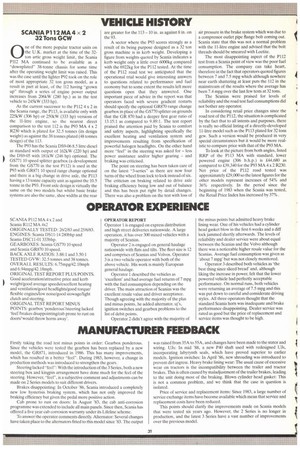VEHICLE HISTORY
Page 191

If you've noticed an error in this article please click here to report it so we can fix it.
SCANIA P112 MA 4 x 2 32 Tons GCW 0 ne of the more popular tractor units on the U.K. market at the time of the 32ton artic gross weight limit, the Scania P112 MA continued to be available as a "downplated" 38-tonne chassis for some time after the operating weight limit was raised. This was the case until the lighter P92 took on the role of most appropriate 32 ton gross model, as a result in part at least, of the 112 having "grown up" through a series of engine power output increases from 206kW (280 hp.) as in the test vehicle to 245kW (333 hp).
As the current successor to the P112 4 x 2 in the Scania range, the P113, is available only with 225kW (306 hp) or 250kW (333 hp) versions of the 11-litre engine, so the nearest direct comparison to the test 112 is the P93 MA 4 x 2 R230 which is plated for 32.5 tonnes (its design weight) as against the 38 tonnes plated (48 tonnes design) of the 113.
The P93 has the Scania DS9-06 8.5 litre diesel as standard with output of 162kW (220 hp) and the DS9-05 with 181kW (246 hp) optional. The 05771 10 speed splitter gearbox (a development from the GS77(J in the test P112) is used in the P93 with GR871 10 speed range change optional and there is a big change in drive axle, the P113 having a 13 tonne capacity unit as against the 10.5 tonne in the P93. Front axle design is virtually the same on the two models but whilst basic brake systems are also the same, shoe widths at the rear are greater for the 113— 10 in. as against 8 in. on the 93.
A sector where the P93 scores strongly as a result of its being purpose designed as a 32 ton gross machine is in kerb weight. Developing a figure from weights quoted by Scania indicates a kerb weight only a little over 6000kg compared with the 6922kg for the P112 tested, At the time of' the P112 road test we anticipated that the operational trial would give interesting answers to questions related to performance and fuel economy but to some extent the results left more questions open that they answered. One important piece of advice in the report was that operators faced with severe gradient restarts should specify the optional GR870 range change gearbox in place of the 0S770 splitter on grounds that the OR 870 had a deeper first gear ratio of 13.15:1 as compared to 9.89:1. The test report praised the attention paid by Scania to comfort and safety aspects, highlighting specifically the excellent heating and ventilation system and improvements resulting from specification of powerful halogen headlights. On the other hand more "feel" in the steering was asked for — less power assistance and/or higher gearing — and braking was criticised.
The point on steering has been taken care of on the latest "3-series" as there are now four turns of the wheel from lock to lock instead of six. The criticism on braking related to drive axle braking efficiency being low and out of balance and this has been put right by detail changes. There was also a problem on the test with loss of air pressure in the brake system which was due to a compressor outlet pipe flange bolt coming out. Scania state that this was not a normal problem with the 11-litre engine and advised that the bolt threads should be smeared with Loctite.
The most disappointing aspect of the P112 test from a Scania point of view was the poor fuel consumption. The company can take heart, therefore in the fact that operators quoted figures between 7 and 7.5 mpg which although nowhere near earth shattering at least puts the 112 in the mainstream of the results where the average has been 7.4 mpg over the last few tests at 32 tons.
The Scanias were praised for levels of reliability and the road test fuel consumptions did not bother any operator.
In considering retail price changes since the road test of the P112, the situation is complicated by the fact that to all intents and purposes. there is really no official listing of a directly-developed 11-litre model such as the P113 plated for 32 tons gcw. Such a version would be produced in very special circumstances but it would be more realistic to compare price with that of the P93 MA.
To look at the picture from both angles, listed RRP of the P113 MA with standard, lower powered engine (306 b.h.p.) is £44,680 as compared to £39,340 for the P93 MA 4 x 2 R230. Net price of the P112 road tested was approximately £29,000 so the latest figures for the other models represent increases of 54% and 36% respectively. In the period since the beginning of 1983 when the Scalia was tested, the Retail Price Index has increased by 37%.
































































































































































































